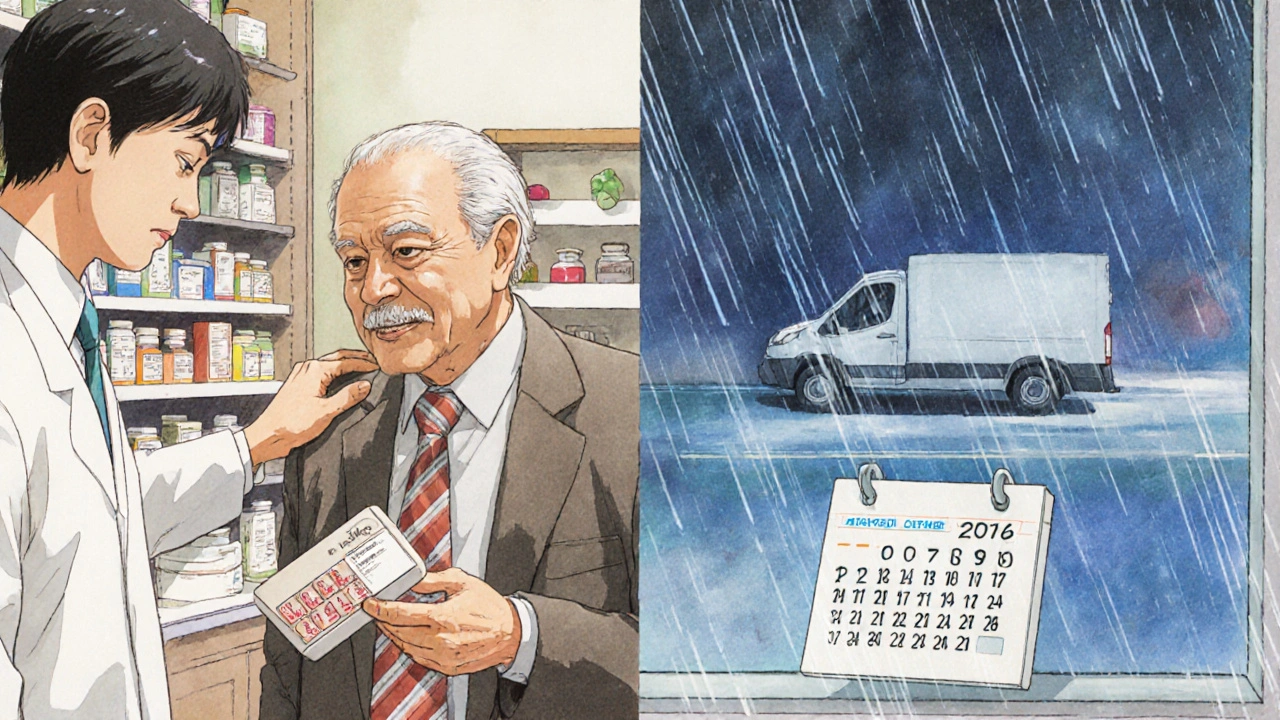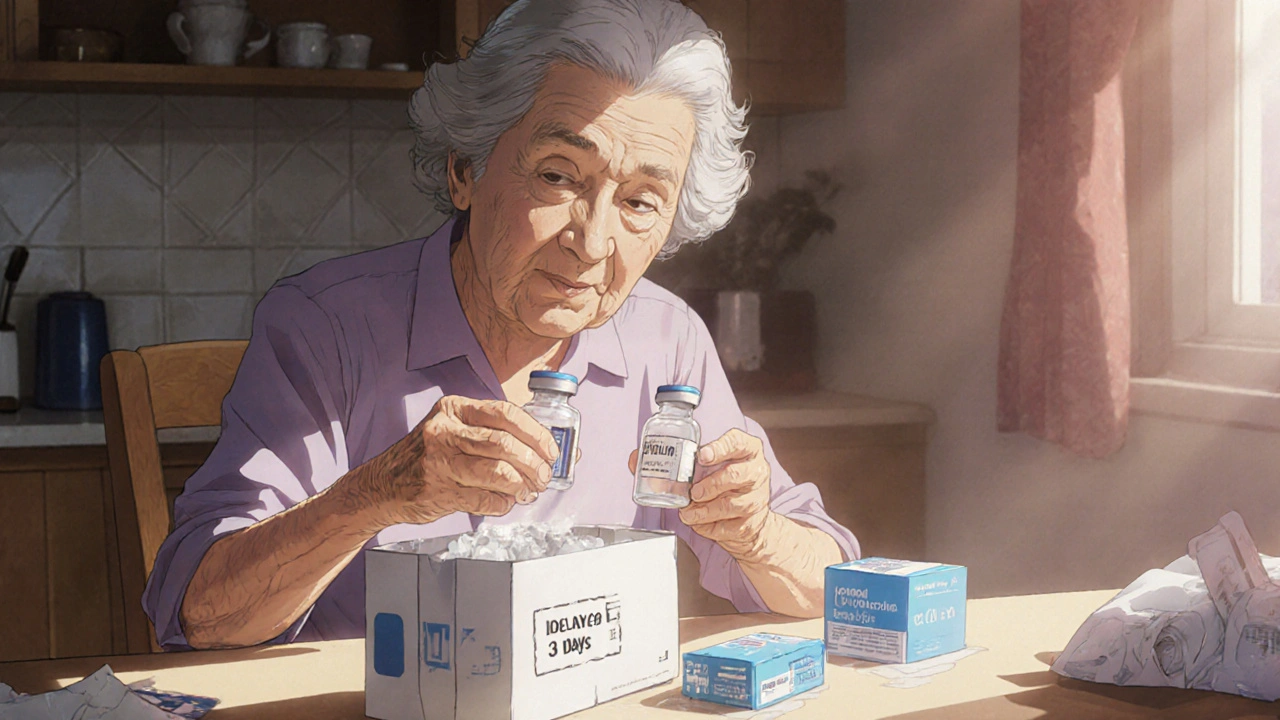Buying your chronic medications through the mail sounds simple: order online, get it delivered to your door, and save money. For millions of people, especially those managing diabetes, high blood pressure, or depression, this system works. But behind the convenience lies a complex reality - one where cost savings can hide dangerous markups, temperature-controlled shipments often fail, and a missing pill can mean a trip to the emergency room.
Why Mail-Order Generics Are Popular
Mail-order pharmacies aren’t new. They’ve been around since the 1950s, but their use exploded after Medicare Part D added them as a covered option in 2006. Today, about 34% of Medicare Part D users rely on them. The numbers tell a bigger story: mail-order sales jumped from $86 billion in 2013 to over $206 billion in 2023. Prescription volume? Only up 11%. That gap points to one thing - prices rose, not usage. The main draw? Convenience and cost. Most plans offer 90-day supplies at a lower copay than 30-day retail fills. For example, a blood pressure pill might cost $10 for a three-month supply through mail-order, but $45 for the same amount at your local pharmacy. That’s a $45 monthly saving for one medication alone. For people on multiple chronic meds, those savings add up fast. Automatic refills and home delivery remove the hassle of driving to the pharmacy, waiting in line, and remembering to refill. That’s huge for older adults, people with mobility issues, or anyone juggling work and family. Studies from the National Institutes of Health show people who use mail-order services are more likely to take their meds regularly. That’s not just convenient - it’s life-saving. Better adherence means fewer hospital visits, lower risk of heart attacks, and better control of conditions like diabetes and high cholesterol.How Mail-Order Pharmacies Work
Most mail-order services are tied to your insurance company’s pharmacy benefit manager (PBM). The big three - Express Scripts (Cigna), CVS Caremark, and OptumRx - handle nearly 80% of all mail-order prescriptions in the U.S. You don’t choose the pharmacy; your insurer does. Your doctor sends the prescription electronically to the PBM’s pharmacy, and they ship it directly to your home, usually within a week. These pharmacies specialize in maintenance drugs - things you take every day for months or years. They don’t stock antibiotics, inhalers for sudden asthma attacks, or painkillers after surgery. If you need something fast, you still need a local pharmacy. You’ll typically get a 90-day supply at a time. That’s good for savings, but it means you need to plan ahead. Waiting until your bottle is empty is risky. If your package gets delayed, you could go without your medication for days - or weeks. Experts recommend ordering at least two weeks before you run out. That’s not a suggestion. It’s a safety rule.The Hidden Costs and Price Manipulation
The big promise? Lower prices. But the reality? It’s not always true. A generic antidepressant might cost $12 at a retail pharmacy. The same pill, through a mail-order service, could be billed at $100 - an 800% markup. Brand-name drugs? Sometimes marked up 35 times the retail price. These aren’t outliers. They’re common practices. How does this happen? PBMs negotiate deals with drug manufacturers and pharmacies. They collect rebates, charge administrative fees, and sometimes even own the mail-order pharmacies they contract with. The savings you think you’re getting? Often, it’s the insurance company’s cut - not yours. Uninsured patients face the worst of this. A month’s supply of semaglutide (a popular weight-loss drug) can cost $500 through direct-to-consumer mail-order sites. That’s more than most people can afford. For those without insurance, mail-order isn’t a bargain - it’s a trap.
Temperature Risks: When Your Medicine Melts
Medications aren’t like books or socks. They need to stay within a specific temperature range - usually between 68°F and 77°F - to stay effective. Insulin, for example, starts breaking down after 24 hours above 86°F. A study in the Journal of the American Pharmacists Association found that only one-third of mail-order medications are shipped within safe temperature ranges. The FDA has logged over 1,200 reports of temperature-related failures between 2020 and 2023. That’s likely just the tip of the iceberg. Most people don’t report it. They just notice their insulin isn’t working, or their seizure medication isn’t controlling their symptoms. Reddit threads are full of stories: insulin packages left on porches in 95°F heat, pills melted into sticky goo, inhalers that stopped spraying after a hot truck ride. One user described opening a box of diabetes meds that smelled like burnt plastic. The pills were useless. He ended up in the ER. There are no federal rules forcing mail-order pharmacies to use temperature-controlled packaging or track conditions during transit. No one’s checking. No one’s being held accountable.Lost, Delayed, or Wrong Medication
Delivery issues are the second most common complaint on Trustpilot, behind only pricing. About 17% of negative reviews mention lost, damaged, or delayed packages. Imagine you’re on blood thinners. You’ve been taking your pill every day for five years. One day, your package doesn’t arrive. You call the pharmacy. They say it was delivered. You check your porch, your mailbox, your neighbor’s yard. Nothing. You’re stuck. No refill. No backup. You skip a day. Then two. Then your INR spikes. You’re rushed to the hospital. Or worse - you get the wrong drug. A mix-up between similar-looking pills. A mislabeled bottle. A pharmacist in a different state fills your script without knowing your full history. You take it. You feel strange. You go to the ER. They find out you were given a drug that interacts dangerously with your other meds. These aren’t rare. They’re systemic.Loss of Personal Care
At your local pharmacy, the pharmacist knows your name. They see you every month. They ask how your knee is doing. They notice you’re not picking up your antidepressant and call to check in. They catch a drug interaction you didn’t know about. Mail-order pharmacies don’t do that. A 2023 Consumer Reports survey found 68% of users worried about losing that personal connection. No one asks if you’re feeling better. No one warns you that your new generic looks different and might cause confusion. And here’s the scary part: switching between different generic brands - even if they’re technically the same - can cause problems. A 2017 study found patients who switched between multiple generic versions of topiramate (used for seizures and migraines) had higher hospitalization rates. Why? Because the pills looked different. They tasted different. Patients got confused. They stopped taking them. For older adults or people with cognitive issues, this isn’t just inconvenient. It’s dangerous.
Who Should Use Mail-Order Generics?
Mail-order isn’t for everyone. But it’s perfect for some. Best for: People taking daily medications for chronic conditions - high blood pressure, cholesterol, diabetes, thyroid disorders, depression, asthma inhalers (if used daily), and arthritis meds. If you take the same pills every day and don’t need them right away, mail-order saves time and money. Not for: Antibiotics, pain meds after surgery, rescue inhalers, insulin if you’re unsure about shipping conditions, or any medication you need immediately. If your life depends on getting it within hours, stick with your local pharmacy.How to Use Mail-Order Safely
If you’re using mail-order, here’s how to protect yourself:- Order early. Set a reminder to refill at least two weeks before you run out.
- Track your package. Use tracking numbers. If it’s delayed, call the pharmacy immediately.
- Check your meds when they arrive. Look at the pills. Do they look like your last bottle? Smell them. Are they sticky? Melted? Discolored? Don’t take them. Call the pharmacy and ask for a replacement.
- Keep a backup. Always have at least a 7-day supply on hand in case of delivery delays.
- Don’t mix pharmacies. If you’re using mail-order for some meds and a local pharmacy for others, make sure both pharmacies know your full list. Ask your local pharmacist to review all your drugs for interactions.
- Ask about cold packs. If you’re getting insulin or other temperature-sensitive drugs, insist on insulated packaging with cold packs. If they don’t offer it, switch providers.
The Future of Mail-Order Generics
By 2027, experts predict mail-order will handle 45% of all chronic medication prescriptions in the U.S. That’s up from 31% today. The push is coming from insurers, who see it as a way to cut costs and improve adherence. But without regulation, this growth is risky. The proposed Pharmacy Delivery Safety Act (H.R. 4892) would require temperature monitoring, tracking, and reporting of damaged medications. It’s stuck in committee. No one’s pushing it hard enough. Until then, you’re on your own. The system works - for some. But it’s not safe. Not reliable. Not fair. The truth? Mail-order generics can be a powerful tool - if you know how to use them. Don’t assume they’re cheaper. Don’t assume they’re safer. Check your pills. Track your delivery. Ask questions. Your life might depend on it.Are mail-order generics as effective as brand-name drugs?
Yes. The FDA requires generic drugs to have the same active ingredients, strength, dosage form, and effectiveness as brand-name versions. They must meet the same strict standards. The only differences are in color, shape, flavor, or inactive ingredients - none of which affect how well the drug works. Many people worry generics are weaker, but that’s a myth. The real issue isn’t effectiveness - it’s consistency and safety during delivery.
Can I switch between different generic brands of the same drug?
Technically, yes - but it’s not always safe. Different generic versions can vary in size, shape, color, or even taste. For some people, especially older adults or those with memory issues, this causes confusion. A study found patients switching between multiple generic versions of topiramate had higher hospitalization rates because they thought the new pill was the wrong medicine and stopped taking it. If you notice your pills look different, ask your pharmacist why and whether it’s safe to switch.
What should I do if my medication arrives damaged or melted?
Do not take it. Take a photo of the damaged package and pills. Call the mail-order pharmacy immediately and request a replacement. If you’re on a life-saving drug like insulin, blood thinners, or seizure medication, contact your doctor right away. You may need a temporary supply from a local pharmacy. Report the incident to the FDA’s MedWatch program - this helps track systemic failures.
Why do mail-order pharmacies charge so much for some drugs?
Mail-order pharmacies are often owned or controlled by pharmacy benefit managers (PBMs), which negotiate drug prices behind the scenes. They may mark up the price of a generic drug dramatically - sometimes 800% or more - then offer a "discount" to your insurance plan. You may think you’re saving money, but the real savings go to the PBM, not you. Uninsured patients often pay the full marked-up price, which can be unaffordable. Transparency is lacking, and there’s little oversight.
Is it safe to use mail-order for insulin?
It can be, but only if you take extra precautions. Insulin is extremely sensitive to heat. If it’s exposed to temperatures above 86°F for more than 24 hours, it loses potency. Many mail-order packages arrive without proper cold packs or insulation. If you use insulin, always request temperature-controlled shipping, track your package, and inspect it immediately upon arrival. If the insulin looks cloudy, clumped, or discolored - don’t use it. Keep a backup supply at home and know where to get emergency insulin locally.
How do I know if my mail-order pharmacy is reliable?
Check if your pharmacy is licensed and accredited by the National Association of Boards of Pharmacy (NABP). Look for the VIPPS seal (Verified Internet Pharmacy Practice Sites). Avoid websites that don’t require a prescription or offer "discounts" that seem too good to be true. If you’re unsure, ask your doctor or local pharmacist for recommendations. Stick with the pharmacy your insurance assigns unless you have a strong reason to switch.


Peter Aultman
November 14, 2025 AT 23:35Been using mail-order for my blood pressure meds for 3 years now. Save like $60 a month. Just make sure you track the package and check the pills when they arrive. One time my insulin box got left in the sun and the vials were warm. I called them right away and got a replacement same day. Don't be lazy about it.
Sean Hwang
November 16, 2025 AT 16:47my grandma used mail order for her diabetes stuff. she got confused when the pills looked different and stopped taking them. ended up in the hospital. now she only takes her meds from the local pharmacy. they know her by name and check on her. no tech can replace that.
Jane Johnson
November 17, 2025 AT 04:16The systemic lack of accountability in pharmaceutical logistics is not merely a failure of regulation-it is a moral indictment of a profit-driven healthcare infrastructure that treats human life as a variable in a cost-benefit algorithm.
Barry Sanders
November 18, 2025 AT 18:59This whole system is a scam. PBMs are just middlemen who get rich while people die because their insulin melted on a porch. Someone needs to burn this whole thing down.
Joe Goodrow
November 18, 2025 AT 19:41People whine about mail-order but don't get it. We're not in the 1950s anymore. If you can't handle a little heat or a delayed package, maybe you shouldn't be managing your own meds. Get a caregiver or move to a country with real healthcare.
Dilip Patel
November 19, 2025 AT 22:46in india we just buy generic meds from local shops for 10 rupees. no shipping no drama. why are americans so obsessed with complicated systems. you want cheap meds go to bangladesh or thailand. problem solved.
Kevin Wagner
November 21, 2025 AT 03:58Look, I get it. The system's broken. But here's the truth-mail-order saved my life. I'm on six meds. Without it, I'd be broke and skipping doses. Yeah, the packaging sucks. Yeah, sometimes the pills look weird. But I’ve got a 7-day backup, I track every box, and I call them the second something’s off. This isn’t about blaming the system-it’s about owning your health. Don’t be a victim. Be a warrior.
Brittany C
November 21, 2025 AT 06:33Per FDA guidelines, the bioequivalence threshold for generics is 80–125% AUC and Cmax. While this ensures therapeutic equivalence, it does not account for inter-batch variability in excipients, which may alter dissolution kinetics-particularly in extended-release formulations. This is clinically significant in narrow-therapeutic-index drugs like warfarin or levothyroxine.
Don Ablett
November 22, 2025 AT 10:25It is worth noting that the absence of standardized temperature monitoring protocols across mail-order pharmacies constitutes a critical gap in pharmacovigilance. The current voluntary compliance framework, coupled with the lack of mandatory reporting mechanisms for thermal excursions, undermines the foundational principles of pharmaceutical integrity. Further, the concentration of market share among three PBMs raises antitrust concerns regarding pricing transparency and consumer autonomy.
kshitij pandey
November 23, 2025 AT 21:24My cousin in Texas uses mail-order for her insulin. She always asks for cold packs and keeps a cooler by the door. She says the pharmacy sends her a text when it’s out for delivery so she can be home. Simple stuff. But it works. You just gotta be smart. No magic, just habits.